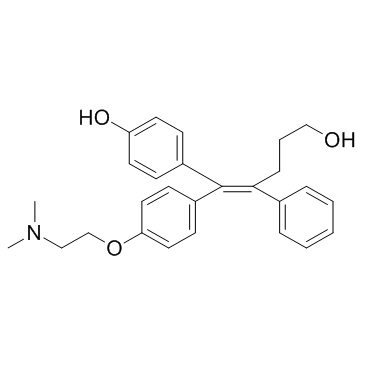877387-37-6
| Name | GSK5182 |
|---|---|
| Synonyms |
GSK5182
4-[(1Z)-1-{4-[2-(dimethylamino)ethoxy]phenyl}-5-hydroxy-2-phenylpent-1-en-1-yl]phenol Benzenebutanol, δ-[[4-[2-(dimethylamino)ethoxy]phenyl](4-hydroxyphenyl)methylene]-, (δZ)- 4-[(1Z)-1-{4-[2-(Dimethylamino)ethoxy]phenyl}-5-hydroxy-2-phenyl-1-penten-1-yl]phenol (Z)-4-(1-{4-[2-(DIMETHYLAMINO)ETHOXY]PHENYL}-5-HYDROXY-2-PHENYLPENT-1-ENYL)PHENOL |
| Description | GSK5182 is a highly selective inverse agonist of estrogen-related receptor γ (ERRγ) with an IC50 of 79 nM and does not interact with other nuclear receptors, including ERRα or ERα, due to its additional non-covalent interactions with Y326 and N346 at the active site of ERRγ. GSK5182 also induces Reactive Oxyen Species (ROS) generation in hepatocellular carcinoma (HCC)[1][2][3]. |
|---|---|
| Related Catalog | |
| Target |
ERRγ:79 nM (IC50) |
| In Vitro | GSK5182 (0-20 μM; 0-hours; PLC/PRF/5 cells) treatment leads to a significant and dose-dependent reduction in the number of proliferating PLC/PRF/5 cells[1]. GSK5182 (0-20 μM; 24 hours; PLC/PRF/5 cells) treatment also causes a dose-dependent increase in the expression of p21 and p27 while at the same time reducing the level of phosphorylated retinoblastoma protein (p-pRb)[1]. GSK5182 (10-20 μM; PLC/PRF/5 cells) treatment induces cell cycle arrest at G1 phase, which in turn induces a corresponding dose-dependent reduction in the percentage of cells in S phase[1]. Cell Proliferation Assay[1] Cell Line: The human hepatoma cell line PLC/PRF/5 Concentration: 0 μM, 10 μM, 20 μM Incubation Time: 0 hour, 24 hours, 48 hours, 72 hours Result: Led to a significant and dose-dependent reduction in the number of proliferating PLC/PRF/5 cells. Western Blot Analysis[1] Cell Line: The human hepatoma cell line PLC/PRF/5 Concentration: 0 μM, 10 μM, 20 μM Incubation Time: 24 hours Result: Caused a dose-dependent increase in the expression of p21 and p27 while at the same time reducing the level of p-pRb. Cell Cycle Analysis[1] Cell Line: The human hepatoma cell line PLC/PRF/5 Concentration: 10 μM, 20 μM Incubation Time: Result: Induced cell cycle arrest. |
| In Vivo | GSK5182 (40 mg/kg; intraperitoneal injection; every day; 25 or 30 days; db/db mice, diet-induced obesity mice) specifically inhibits the transcriptional activity of ERRγ, and suppresses hepatic glucose production through inhibition of hepatic gluconeogenesis. GSK5182 elicits anti-diabetic effects in mouse models via negative regulation of the hepatic gluconeogenesis program. GSK5182 normalizes hyperglycemia mainly through inhibition of hepatic glucose production[3]. Animal Model: db/db mice (male, 7-12-week-old), diet-induced obesity (DIO) mice[3] Dosage: 40 mg/kg Administration: Intraperitoneal injection; every day; 30 days for db/db mice, 25 days for DIO mice Result: Inhibited the transcriptional activity of ERRγ, suppressed hepatic glucose production through inhibition of hepatic gluconeogenesis. |
| References |
| Density | 1.132±0.06 g/cm3(Predicted) |
|---|---|
| Boiling Point | 567.6±50.0 °C(Predicted) |
| Molecular Formula | C27H31NO3 |
| Molecular Weight | 417.55 |
| Storage condition | -20°C |
| Hazard Codes | Xn |
|---|
